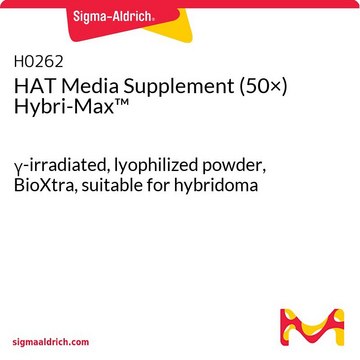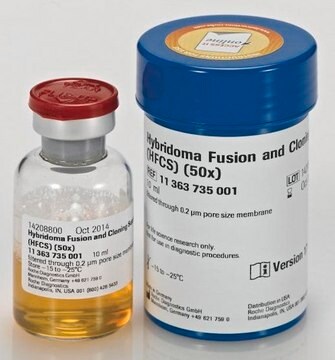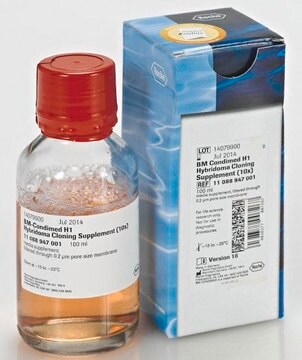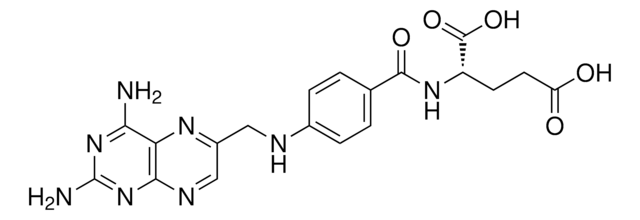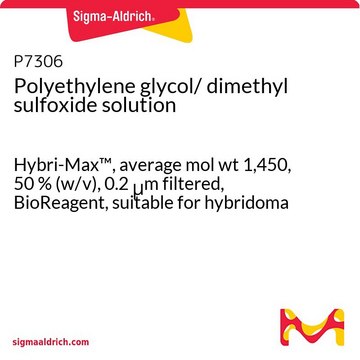H0137
HT Media Supplement (50×) Hybri-Max™
lyophilized powder, suitable for hybridoma, BioXtra
Synonym(s):
HT Supplement, Hypoxanthine-Thymidin (HT) media supplement
Sign Into View Organizational & Contract Pricing
All Photos(1)
About This Item
UNSPSC Code:
12352207
NACRES:
NA.75
Recommended Products
Product Name
HT Media Supplement (50×) Hybri-Max™, lyophilized powder, γ-irradiated, BioXtra, suitable for hybridoma
Quality Level
sterility
γ-irradiated
product line
BioXtra
form
lyophilized powder
technique(s)
cell culture | hybridoma: suitable
impurities
endotoxin, tested
storage temp.
−20°C
Application
HT Media supplement is a cocktail hypoxanthine and thymidine qualified for use in hybridoma selection and cell culture applications. HT Media Supplement (50×) Hybri-Max™ has been used as a supplement in INS-1 β-cells co-culture medium. It is suitable for use as medium for hybridoma cells and as Dulbecco′s Modified Eagle Medium (DMEM) for HeLa S3 and MTH1-KO cells.
Reconstitution
Reconstitute contents of vial with 10 ml sterile cell culture medium. Stock solution is sufficient to prepare 500 ml medium. Final working concentration: 100 μM hypoxanthine, 16 μM thymidine.
Legal Information
Hybri-Max is a trademark of Sigma-Aldrich Co. LLC
Storage Class Code
11 - Combustible Solids
WGK
WGK 3
Flash Point(F)
Not applicable
Flash Point(C)
Not applicable
Personal Protective Equipment
dust mask type N95 (US), Eyeshields, Gloves
Choose from one of the most recent versions:
Already Own This Product?
Find documentation for the products that you have recently purchased in the Document Library.
Customers Also Viewed
Characterization of an IgG monoclonal antibody targeted to both tissue cyst and sporocyst walls of Toxoplasma gondii
Gondim L, et al.
Experimental Parasitology, 163, 46-56 (2016)
Simulated Cholinergic Reinnervation of beta (INS-1) Cells: Antidiabetic Utility of Heterotypic Pseudoislets Containing beta Cell and Cholinergic Cell
Jiao A, et al.
International Journal of Endocrinology, 2018 (2018)
The roles of human MTH1, MTH2 and MTH3 proteins in maintaining genome stability under oxidative stress
Hashiguchi K, et al.
Mutation Research. Fundamental and Molecular Mechanisms of Mutagenesis, 808, 10-19 (2018)
Kimberly A McCormack et al.
Parasitology research, 118(8), 2409-2417 (2019-06-15)
Human babesiosis, a tick-borne disease similar to malaria, is most often caused by the hemoprotozoans Babesia divergens in Europe, and Babesia microti and Babesia duncani in North America. Babesia microti is the best documented and causes more cases of human
Emmanuel Osei Mensah et al.
Journal of bioscience and bioengineering, 128(4), 487-494 (2019-04-30)
Since the use of protein therapeutics is effective for treating intractable human diseases, the production of biologic therapeutic agents has dramatically increased over the past three decades. The Chinese hamster ovary (CHO) cell lines are the most commonly used host
Protocols
Protocol Guide: XTT Assay for Cell Viability and Proliferation
Our team of scientists has experience in all areas of research including Life Science, Material Science, Chemical Synthesis, Chromatography, Analytical and many others.
Contact Technical Service